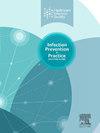Compliance with infection control practices among healthcare workers in radiology departments: a participant observation study and adenosine triphosphate assay evaluation of environmental cleanliness
IF 1.9
Q3 INFECTIOUS DISEASES
引用次数: 0
Abstract
Background
Increased risk of healthcare-associated infections (HAIs) in radiology departments has been reported in recent years. Optimal infection control practices (ICPs) are the key to controlling HAIs, but few studies have investigated the ICP compliance of healthcare workers (HCWs) in radiology departments.
Aim
To assess the level of ICP compliance of HCWs in a radiology department.
Methods
A participant observation supplemented with adenosine triphosphate (ATP) bioluminescence assay evaluation of environmental cleanliness was conducted. More than 1000 hand hygiene (HH) opportunities and 960 opportunities for the other core ICP elements were observed in different study units of a radiology department. An online checklist powered by eRub was used to record the HCWs' ICP performance. A total of 125 environmental samples were collected for ATP assay evaluation.
Results
In the participants observation, the overall performance score was 41.4%. The lowest score was found in HH (10.4%), followed by use of personal protective equipment (29.4%) and gloves (68.2%). The HH performance was significantly associated with study units (χ2 = 42.55, P < 0.001), professional groups (χ2 = 110.21, P < 0.001), and patient-to-staff ratio (F = 8.76, P < 0.001). With relative light units of ≤250 set as a pass benchmark, less than two-thirds of the environmental samples passed the ATP assay.
Conclusion
The overall ICP compliance among the HCWs in the radiology department was suboptimal. Revisions of current ICP guidelines and policies that are tailored to the setting-specific needs and barriers in radiology departments is necessary.
放射科医护人员对感染控制措施的依从性:一项参与性观察研究和环境清洁度的三磷酸腺苷测定评价
背景:近年来,有报道称放射科的医疗保健相关感染(HAIs)风险增加。最佳感染控制措施(ICP)是控制HAIs的关键,但很少有研究调查放射科医护人员(HCWs)对ICP的依从性。目的评价某放射科医护人员对ICP的依从性。方法采用参与观察加三磷酸腺苷(ATP)生物发光法评价环境洁净度。在某放射科的不同研究单位观察到1000多个手部卫生(HH)机会和960多个其他核心ICP要素的机会。使用由eRub提供支持的在线检查表记录医护人员的ICP表现。共收集125份环境样品进行ATP测定评价。结果在参与者观察中,整体表现得分为41.4%。HH(10.4%)得分最低,其次是使用个人防护装备(29.4%)和手套(68.2%)。HH表现与研究单位显著相关(χ2 = 42.55, P <;0.001),专业组(χ2 = 110.21, P <;0.001),患者与工作人员比率(F = 8.76, P <;0.001)。以相对光单位≤250作为通过基准,不到三分之二的环境样品通过ATP测定。结论放射科医护人员总体ICP依从性不理想。有必要修订现行的ICP指南和政策,以适应放射科的具体需要和障碍。
本文章由计算机程序翻译,如有差异,请以英文原文为准。
求助全文
约1分钟内获得全文
求助全文
来源期刊

Infection Prevention in Practice
Medicine-Public Health, Environmental and Occupational Health
CiteScore
4.80
自引率
0.00%
发文量
58
审稿时长
61 days
 求助内容:
求助内容: 应助结果提醒方式:
应助结果提醒方式:


